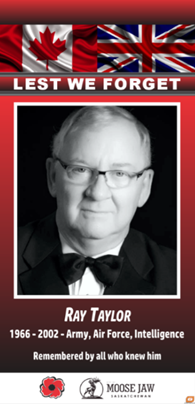The veterans’ banners on Main Street feature men who had interesting lives, including one who received a medal from the United States for his intelligence efforts and another who was passionate about community baseball.
Below are the biographies of two men who appear on the banners. The information comes from the City of Moose Jaw website.
This is part 6 of 7.
Ray Taylor
Ray Taylor had an amazing career in the Canadian Armed Forces, retiring in 2002 as lieutenant colonel after 37 years of service.
After beginning with the Queen’s Own Rifles in 1967, Ray joined the Princess Patricia’s Canadian Light Infantry (PPCLI) in Germany. After returning, he joined the security branch and was posted to Cold Lake, Alta., and then Trenton, Ont. as base security officer. During his time in Trenton, he oversaw aircraft security for the Royal Family while they were in Canada and Prime Minister Pierre Elliot Trudeau when he left Canada.
Ray spent many years based in Ottawa in the Privy Council Office and at Canadian Forces Headquarters. He did a wide variety of jobs in Ottawa: undercover surveillance, counterintelligence, intelligence analyst, senior briefer of the most senior Canadian Government officials, a tour with the United Nations, and training diplomats on how to stay safe in foreign countries.
His next posting was as an intelligence liaison officer in London, England, and then he was back at NDHQ in Ottawa and Staff College in Toronto. During this time in Ottawa, he was known as the pre-eminent Middle East intelligence analyst and became head of the Soviet Air Forces Analysis Division.
His next big move was to Winnipeg as the air command intelligence officer. Here, he managed all the intelligence functions and all the intelligence resources for the Royal Canadian Air Force. His career concluded in Washington, D.C., where he served as chief of the Canadian Forces Intelligence Liaison Office.
He was known to have contributed significantly to the process of intelligence and co-operation between the United States and Canada.
Ray Taylor worked hard for his country and was involved in every international military event from the Cold War to the Balkans War, including Cyprus, Egypt, Lebanon, Guatemala, Rwanda, Kosovo, and Bosnia, to name just a few.
He earned many accolades and decorations throughout his career, including the Peacekeeping Decoration for the Nobel Peace Prize and the Queen Elizabeth II Diamond Jubilee Medal.
He was most proud of being awarded the Legion of Merit (Officer) by the United States for his service in Washington. This award was created for citizens of other nations to honour “exceptionally meritorious conduct in the performance of outstanding service to the United States.”
The Legion of Merit had never been awarded to a serving, non-retired individual.
Cecil Staples
Cecil Nesbitt Staples was born on Feb. 26, 1919. He was raised on a farm southeast of Moose Jaw in the Petrolia District, where he attended school and played ball on the local team.
He joined the army in November 1940 and transferred to the Royal Canadian Air Force (RCAF) in November 1941. After training in Edmonton, St. Thomas, and Mont Joli, he left for England on Jan. 1, 1944.
Cecil was discharged from the RCAF in September 1945 as a Leading Aircraftsman and returned to work on the family farm. He joined the Petrolia baseball team, and it was at a local ball tournament he met the love of his life, Marjorie Duncan, a teacher at Pasqua.
On Jan. 9, 1948, Cecil and Marj were married, stayed on the farm, and raised four children. While farming, he also worked at the CPR, drove a taxi and hail adjusted. They enjoyed square dancing and made many lifetime friends. Cecil and Marj also travelled to New Zealand, Hawaii, and the Maritimes and wintered in California, Arizona, and Texas.
When at home, they loved to spend time with family, which had grown by 10 grandchildren and 14 great-grandchildren.
They sold the farm in 1975 and moved to Moose Jaw, where Cecil enjoyed working in property management. They were able to live independently until Cecil’s death in May 2015. Although Cecil found it difficult to speak of his time during the Second World War to his children, he did open up and shared memories and pictures with his grandchildren.




